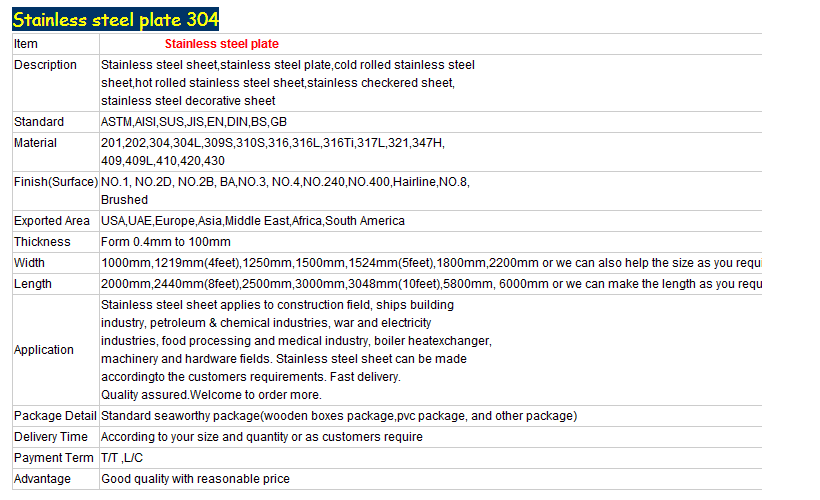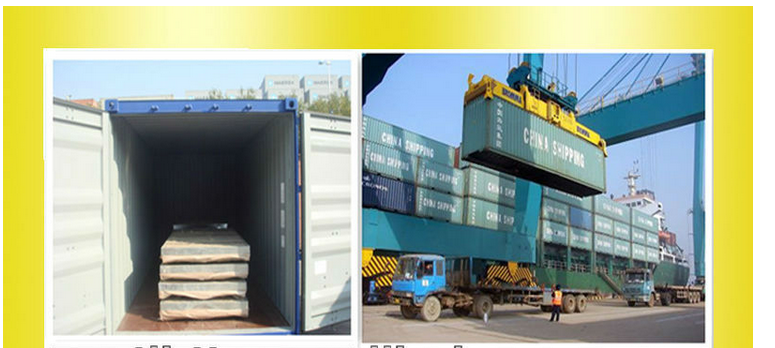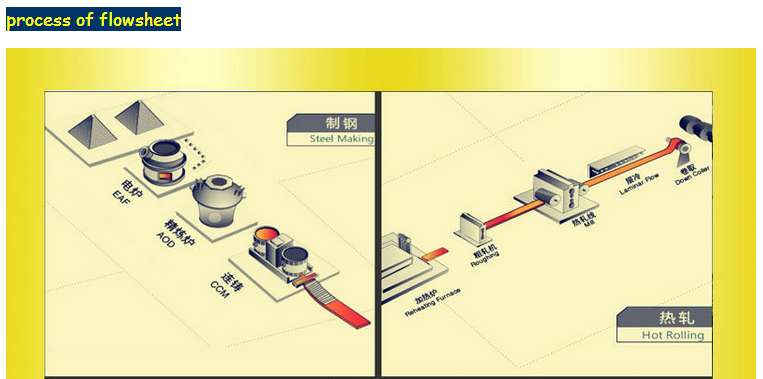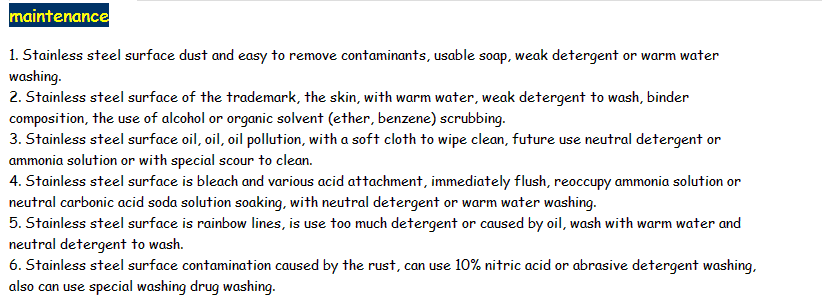316 Made in china Tisco 304 stainless steel plate
- Loading Port:
- Tianjin
- Payment Terms:
- TT OR LC
- Min Order Qty:
- 100 kg
- Supply Capability:
- 1000 kg/month
OKorder Service Pledge
Quality Product, Order Online Tracking, Timely Delivery
OKorder Financial Service
Credit Rating, Credit Services, Credit Purchasing
You Might Also Like






- Q:How do you insulate stainless steel pipes?
- To prevent heat loss, condensation, and energy wastage, insulating stainless steel pipes is a crucial step. There are multiple effective methods available for insulating these pipes: 1. Pipe insulation wraps: The most common and cost-effective method involves using wraps made of materials like fiberglass, rubber, or foam. These wraps are easy to install and provide excellent insulation against heat transfer. They also serve as a barrier to prevent condensation. 2. Insulation jackets: Pre-formed covers made of insulation materials such as mineral wool or fiberglass are used for this method. These jackets are designed to fit around the stainless steel pipes and are secured with adhesive or straps. They offer a high level of thermal insulation and are ideal for pipes in areas with extreme temperatures. 3. Spray foam insulation: This method entails spraying a layer of polyurethane foam insulation directly onto the stainless steel pipes. This creates a seamless and durable insulation layer that adheres well to the pipes, providing excellent thermal insulation and preventing moisture buildup. 4. Insulation tape: Foam or rubber insulation tape is wrapped around the stainless steel pipes to provide thermal insulation. This method works best for smaller pipes or areas with limited space. Regardless of the chosen method, it is important to consider the temperature range, moisture exposure, and specific requirements of the stainless steel pipes when selecting insulation materials. Additionally, proper installation and maintenance of the insulation are essential to optimize its effectiveness and durability.
- Q:What is the difference between 316 and 316Ti stainless steel pipes?
- The main difference between 316 and 316Ti stainless steel pipes lies in their carbon content. While both grades are highly corrosion-resistant and suitable for a wide range of applications, 316Ti contains a small amount of titanium, which gives it enhanced resistance to sensitization. Sensitization occurs when stainless steel is heated in the range of 500-900°C, causing the formation of chromium carbides that can lead to intergranular corrosion. By adding titanium, 316Ti stainless steel pipes are able to prevent the formation of these carbides by reacting with the carbon, thus maintaining the corrosion resistance of the material even when exposed to high temperatures. This makes 316Ti pipes more suitable for applications involving elevated temperatures or prolonged exposure to corrosive environments. In terms of mechanical properties, both grades exhibit similar strength and toughness. However, due to the addition of titanium, 316Ti may have slightly lower ductility compared to 316. It is important to note that the difference in carbon content between these two grades is small, typically less than 0.08%. In summary, the addition of titanium in 316Ti stainless steel pipes provides improved resistance to sensitization and intergranular corrosion, making it a preferred choice for applications involving high temperatures or corrosive environments.
- Q:What is the difference between 304 and 316 stainless steel pipes?
- The main difference between 304 and 316 stainless steel pipes lies in their composition. While both alloys are corrosion-resistant, 316 stainless steel contains higher levels of molybdenum and nickel, making it more resistant to pitting and crevice corrosion in chloride environments. Additionally, 316 stainless steel offers better overall corrosion resistance and increased strength at elevated temperatures compared to 304 stainless steel pipes.
- Q:What is the difference between duplex and super duplex stainless steel pipes?
- Duplex and super duplex stainless steel pipes are variations of stainless steel that have enhanced corrosion resistance and superior strength compared to traditional stainless steel pipes. However, there are some important distinctions between the two. Duplex stainless steel pipes consist of a mixture of austenite and ferrite phases, with approximately equal amounts of each. This well-balanced composition provides excellent resistance to stress corrosion cracking, pitting, and crevice corrosion. Additionally, duplex stainless steel pipes have higher strength than austenitic stainless steels, making them suitable for applications that require increased mechanical strength. In contrast, super duplex stainless steel pipes have a higher concentration of alloying elements like chromium, molybdenum, and nitrogen. This leads to a microstructure with a greater proportion of ferrite phase, further enhancing the material's corrosion resistance and strength. Super duplex stainless steel pipes are particularly resistant to chlorides, making them ideal for applications exposed to aggressive environments such as seawater, chemical processing, and the oil and gas industries. Regarding mechanical properties, super duplex stainless steel pipes generally possess higher tensile strength and yield strength compared to duplex stainless steel pipes. This heightened strength enables super duplex stainless steel pipes to withstand greater pressures and temperatures. Both duplex and super duplex stainless steel pipes offer exceptional corrosion resistance, but the super duplex variation provides superior resistance to a wider range of corrosive environments. It is important to note, however, that super duplex stainless steel pipes are more costly than duplex stainless steel pipes due to their higher alloy content. Ultimately, the choice between duplex and super duplex stainless steel pipes hinges on specific application requirements, such as the severity of the corrosive environment, necessary mechanical strength, and budgetary considerations.
- Q:How do you prevent stress corrosion cracking in stainless steel pipes?
- One way to prevent stress corrosion cracking in stainless steel pipes is to ensure proper material selection. Using stainless steel grades that are resistant to stress corrosion cracking, such as duplex or super duplex stainless steel, can significantly reduce the risk. Additionally, maintaining a suitable environment by controlling temperature, pH levels, and exposure to corrosive substances can also help prevent stress corrosion cracking. Regular inspection and maintenance, including cleaning and passivation, can further enhance the integrity and durability of stainless steel pipes, minimizing the chances of stress corrosion cracking.
- Q:Can stainless steel pipes be insulated with polyvinylidene fluoride?
- Certainly. Polyvinylidene fluoride (PVDF) is capable of insulating stainless steel pipes effectively. PVDF, a polymer known for its exceptional durability and resistance to high temperatures, is frequently employed for insulation purposes. Due to its impressive chemical resistance, UV stability, and flame retardant characteristics, PVDF is an ideal choice for insulating stainless steel pipes in a wide range of applications. By utilizing PVDF insulation, heat loss or gain can be minimized, corrosion can be prevented, and the stainless steel pipes can be provided with added mechanical protection.
- Q:What is the internal roughness of stainless steel pipes?
- The texture or surface finish on the inner walls of stainless steel pipes is what is referred to as the internal roughness. This roughness measures the irregularities or bumps found on the inside surface. Typically, this roughness is quantified by measuring the average height of these irregularities, which is commonly expressed as Ra or Rz. Stainless steel pipes are well-known for their smoothness and resistance to corrosion, making them suitable for various applications in industries such as oil and gas, food processing, pharmaceuticals, and chemicals. Due to their low internal roughness, these pipes experience minimal frictional resistance to fluid flow and offer improved hygienic properties. The internal roughness can vary depending on factors such as the manufacturing process, the grade of stainless steel used, and the intended application. Different surface finishes, including pickled, annealed, or polished, can be applied during the manufacturing process, which can affect the internal roughness. Polished surfaces, in particular, tend to have lower roughness values, resulting in smoother flow and reduced risk of contamination in applications requiring high cleanliness standards. When designing systems involving fluid flow, it is crucial to take into account the internal roughness of stainless steel pipes, as it can impact pressure drop, flow rate, and overall efficiency. Fluid dynamics calculations often consider the roughness value when determining the friction factor in pipe flow equations. To achieve the desired internal roughness, stainless steel pipes often undergo post-processing treatments like electropolishing or mechanical polishing. These treatments further reduce the roughness and enhance the surface finish, thereby improving the performance and lifespan of stainless steel pipes in critical applications that require minimal frictional resistance, high cleanliness, and corrosion resistance.
- Q:What is the difference between Schedule 20 and Schedule 40 stainless steel pipes?
- The main difference between Schedule 20 and Schedule 40 stainless steel pipes lies in their wall thickness and pressure ratings. Schedule 20 stainless steel pipes have a thinner wall thickness compared to Schedule 40 pipes. This means that they have a larger internal diameter, allowing for a higher flow rate of liquids or gases through the pipe. Schedule 20 pipes are commonly used in applications where a lower pressure rating is sufficient, such as residential plumbing or light-duty industrial applications. On the other hand, Schedule 40 stainless steel pipes have a thicker wall thickness than Schedule 20 pipes. This thicker wall provides increased strength and durability, making Schedule 40 pipes suitable for high-pressure applications. They are commonly used in industries like oil and gas, chemical processing, or heavy-duty industrial processes. In terms of pressure ratings, Schedule 20 stainless steel pipes typically have a lower pressure rating compared to Schedule 40 pipes. This is due to the thinner wall thickness of Schedule 20 pipes, which cannot withstand as high pressure as Schedule 40 pipes with their thicker walls. It is important to note that both Schedule 20 and Schedule 40 stainless steel pipes are made from the same material, which is stainless steel. The difference lies solely in their wall thickness and subsequent pressure ratings, making them suitable for different applications based on the required pressure and flow rate.
- Q:How do you calculate the flow velocity in stainless steel pipes?
- In order to determine the flow velocity in stainless steel pipes, one must take into account multiple factors. Firstly, it is necessary to be acquainted with the flow rate or volumetric flow rate (Q) of the fluid that passes through the pipe. This can be ascertained by measuring the volume of fluid that traverses the pipe within a given time period. Subsequently, the cross-sectional area (A) of the pipe needs to be determined. For circular pipes, this can be computed using the formula A = πr², where r denotes the radius of the pipe. Once both the flow rate (Q) and cross-sectional area (A) are known, the flow velocity (V) can be calculated using the formula V = Q / A. It is worth noting that the flow velocity may undergo variations along the length of the pipe due to factors such as friction and changes in pipe diameter. In such instances, more advanced calculations or simulations may be required to accurately ascertain the flow velocity at specific points within the pipe. Furthermore, it is crucial to take into consideration the properties of the fluid being transported, such as viscosity and density, as they can also impact the flow velocity.
- Q:What is the density of stainless steel pipes?
- The density of stainless steel pipes typically ranges from 7.9 to 8.0 grams per cubic centimeter.
1. Manufacturer Overview |
|
|---|---|
| Location | |
| Year Established | |
| Annual Output Value | |
| Main Markets | |
| Company Certifications | |
2. Manufacturer Certificates |
|
|---|---|
| a) Certification Name | |
| Range | |
| Reference | |
| Validity Period | |
3. Manufacturer Capability |
|
|---|---|
| a)Trade Capacity | |
| Nearest Port | |
| Export Percentage | |
| No.of Employees in Trade Department | |
| Language Spoken: | |
| b)Factory Information | |
| Factory Size: | |
| No. of Production Lines | |
| Contract Manufacturing | |
| Product Price Range | |
Send your message to us
316 Made in china Tisco 304 stainless steel plate
- Loading Port:
- Tianjin
- Payment Terms:
- TT OR LC
- Min Order Qty:
- 100 kg
- Supply Capability:
- 1000 kg/month
OKorder Service Pledge
Quality Product, Order Online Tracking, Timely Delivery
OKorder Financial Service
Credit Rating, Credit Services, Credit Purchasing
Similar products
New products
Hot products
Hot Searches
Related keywords



























